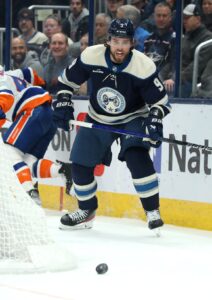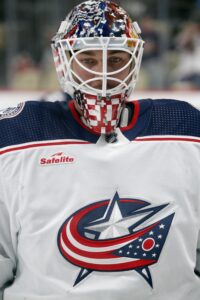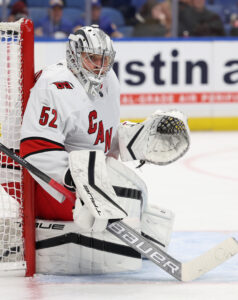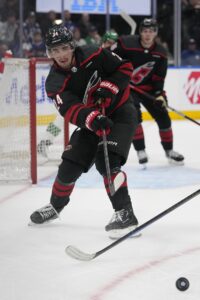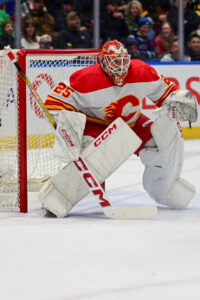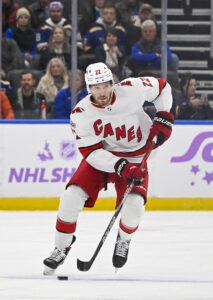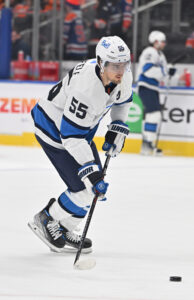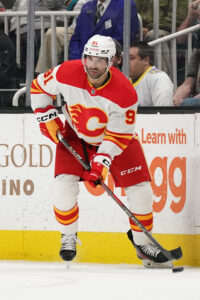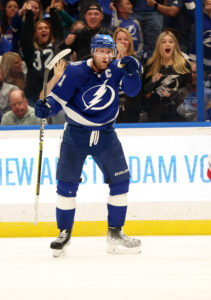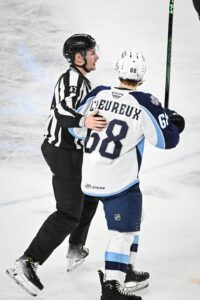Navigating the salary cap is one of the most important tasks for a front office. Teams that can avoid total cap chaos by walking the tightrope of inking players to deals that match their value (or compensate for future value without breaking the bank) remain successful. Those that don’t often see struggles and front office changes.
PHR will look at every NHL team and give a thorough look at their cap situation heading into the 2024-25 season. This will focus more on players who are regulars on the roster versus those who may find themselves shuttling between the AHL and NHL. All cap figures are courtesy of PuckPedia. We’re currently covering the Metropolitan Division, next up is New Jersey.
New Jersey Devils
Current Cap Hit: $87,023,897 (under the $88MM Upper Limit)
Entry-Level Contracts
D Luke Hughes (one year, $925K)
D Simon Nemec (two years, $918K)
Potential Bonuses
Hughes: $1.85MM
Nemec: $3.25MM
Total: $5.1MM
Hughes had a strong rookie season offensively, notching 47 points while maxing out his $850K of ‘A’ bonuses in the process. Even with that being his only full season of experience, with the way young blueliners have been locked up lately, a max-term agreement could be coming his way, one that could run past $8MM. However, an injury to start the season won’t help his cause. Nemec, meanwhile, spent most of last season in New Jersey, acquitting himself well to the NHL. He doesn’t have quite the offensive upside that Hughes does but he could be an all-situations player; that, coupled with his lofty draft status (second overall in 2022), could have him surpassing $8MM on his next contract if he progresses as expected.
Signed Through 2024-25, Non-Entry-Level
G Jake Allen ($1.925MM, UFA)*
F Nathan Bastian ($1.35MM, UFA)
D Nick DeSimone ($775K, UFA)
D Johnathan Kovacevic ($758K, UFA)
F Curtis Lazar ($1MM, UFA)
F Tomas Tatar ($1.8MM, UFA)
*-Montreal is retaining an additional $1.925MM on Allen’s contract.
Tatar returns to New Jersey after a particularly rough season between Colorado and Seattle but he’s only a year removed from putting up 48 points with the Devils. It’s possible that he’s on the decline but it’s reasonable to think he’ll produce enough to warrant this price tag. He hasn’t fared well lately in free agency so even if he rebounds, he probably won’t command a huge jump in salary. Bastian is a capable fourth liner who showed some offensive upside in 2021-22 but will need to get back to that level if he wants to match this deal next summer let alone beat it. Lazar is coming off a career year offensively which is an outlier relative to the rest of his career. If he can repeat the 25 points he had, he could double this price point or even more. However, if he goes more to his career averages, a small increase is about the best he could hope for.
DeSimone was a midseason waiver claim from Calgary and held his own in a depth role. It’d be surprising to see him advance past that this season so he’s likely to stay around the minimum salary moving forward. Kovacevic came over in a trade from Montreal over the summer after largely holding down a spot on the third pairing the last two years. While a lot will depend on if he can play a regular role this season, the fact he’s a right-shot defender with some experience under his belt could give him a shot at doubling his current rate next summer.
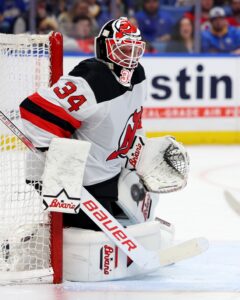 Allen also was acquired from Montreal, this time back at the trade deadline where he stabilized things between the pipes down the stretch. Stabilizing is a fitting description for what Allen’s best role is at this point of his career. He can handle a starting workload for brief stretches but is best utilized in a platoon type of role or as a high-end backup which is where he’ll be this season. The market for those types of netminders has flattened out somewhat in recent years, however, while the fact he’ll be 35 heading into 2025-26 will also hurt him. It’s possible that he can get a two-year deal but a possible comparable might be the two-year, $5MM pact that Cam Talbot received from Detroit this summer.
Allen also was acquired from Montreal, this time back at the trade deadline where he stabilized things between the pipes down the stretch. Stabilizing is a fitting description for what Allen’s best role is at this point of his career. He can handle a starting workload for brief stretches but is best utilized in a platoon type of role or as a high-end backup which is where he’ll be this season. The market for those types of netminders has flattened out somewhat in recent years, however, while the fact he’ll be 35 heading into 2025-26 will also hurt him. It’s possible that he can get a two-year deal but a possible comparable might be the two-year, $5MM pact that Cam Talbot received from Detroit this summer.
Signed Through 2025-26
F Paul Cotter ($775K, RFA)
F Erik Haula ($3.15MM, UFA)
G Jacob Markstrom ($4.125MM, UFA)*
*-Calgary is retaining an additional $1.85MM on Markstrom’s contract.
Haula hasn’t been able to get back to the level of production he had when he started with Vegas in 2017-18 but he has settled in nicely over the last three seasons as someone who will play around a 15-goal, 40-point pace. That price point for a center is solid value but he’ll also be 35 when this deal is up which could limit his shot at a raise in 2026. Cotter was acquired from Vegas this summer as a way for the Devils to add some more grit to their lineup. Part of the reason the price was relatively high (Alexander Holtz and Akira Schmid) is the fact he’s signed for two more years at the league minimum. Cotter could triple that or more on his next deal if he plays at a similar rate for the next two seasons.
It took a little longer than first expected to get Markstrom to New Jersey but they got the deal done before the draft. He’s a solid starter although he’s also getting closer to the end of his career as he’s already 34. Accordingly, even if the starting goalie market goes up (depending on what contracts Jeremy Swayman and Igor Shesterkin get), Markstrom is likelier to stay closer to his current price point if he can maintain his current level for two more seasons.
Signed Through 2026-27
D Brenden Dillon ($4MM, UFA)
F Nico Hischier ($7.25MM, UFA)
F Kurtis MacDermid ($1.15MM, UFA)
F Dawson Mercer ($4MM, RFA)
F Stefan Noesen ($2.75MM, UFA)
F Ondrej Palat ($6MM, UFA)
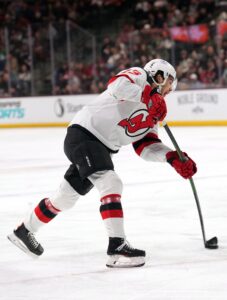 At the time that Hischier’s contract was signed, he had just two seasons under his belt so there was certainly some risk to a max-term commitment at the time. However, it has worked out rather well so far for the Devils as it is already below market value at the time he’s entering his prime years. (The success of this contract provided a road map for other teams to take similar approaches with their top youngsters as well as these types of contracts are much more prevalent now.) Hischier probably won’t produce enough to be viewed as a true number one center but his two-way game is strong enough that there will be teams that treat him as one. Accordingly, between that and the fact he’ll hit free agency at 28, Hischier could command a double-digit AAV on his next contract.
At the time that Hischier’s contract was signed, he had just two seasons under his belt so there was certainly some risk to a max-term commitment at the time. However, it has worked out rather well so far for the Devils as it is already below market value at the time he’s entering his prime years. (The success of this contract provided a road map for other teams to take similar approaches with their top youngsters as well as these types of contracts are much more prevalent now.) Hischier probably won’t produce enough to be viewed as a true number one center but his two-way game is strong enough that there will be teams that treat him as one. Accordingly, between that and the fact he’ll hit free agency at 28, Hischier could command a double-digit AAV on his next contract.
Palat hasn’t been able to produce at the levels he did with Tampa Bay over his first two seasons with New Jersey with injuries being an issue at times as well. Already 33, if he’s not able to turn things around, this is a deal that could be problematic for them as GM Tom Fitzgerald continues to try to add to his roster. Mercer was all but guaranteed to land a bridge contract given New Jersey’s current cap situation but the fact they got a third season at that price point will help. However, it takes him to within a year of UFA eligibility so it’s not without its risk. Mercer will be owed a $4.25MM qualifying offer with arbitration rights and if he can get back to his 2022-23 production (56 points), he could add a few million per year to that number.
Noesen proved to be quite a bargain for Carolina for the last two seasons, recording 36 and 37 points for a cap hit below the league minimum. That helped earn him this deal, well above the six-figure price tags he was accustomed to getting. Is this his new baseline performance? He’ll need it to be if he is going to stay around this price moving forward. MacDermid signed this deal back in May to avoid free agency. It’s a reasonable price tag for an enforcer and falls within the range of some of the more established options. It’s also fully buriable in the minors if they decide a tough guy is something they can no longer afford to carry.
Dillon was part of the defensive makeover this summer, coming over from Winnipeg. This will be seasons 11 through 13 that he makes more than $3MM with this price tag being the highest. He’ll be 36 when he tests the market again and if he’s still a fourth or fifth blueliner at that time, that streak could be extended though potentially on a year-to-year basis moving forward.



